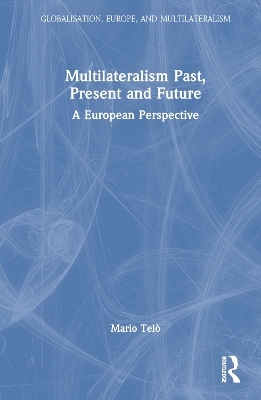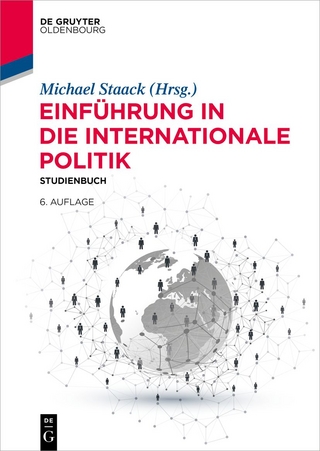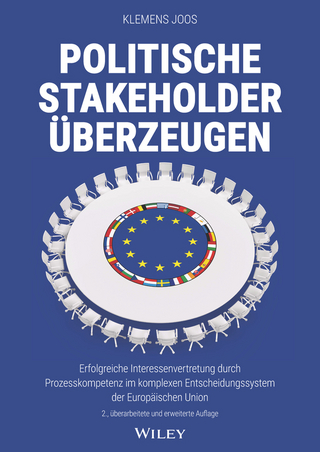
Multilateralism Past, Present and Future
Routledge (Verlag)
978-1-032-24544-7 (ISBN)
It provides a critical reconstruction of the history of the idea and praxis of peaceful global governance, a comparative analysis of regional multilateral organisations and a discussion about concrete trends and perspectives of a new multilateralism against the challenging context of the current multipolar power politics. Focusing on the changing European interplay with multilateralism – from Eurocentric cradle of civilian cooperation among sovereign imperial states, to political dwarf after the two world wars and decolonisation, and to potential co-leader of a multilayered and multi-actor cooperation within the current multipolar order, it addresses a theoretical “gap” by fuelling the long-recognised idealism v. realism debate over international cooperation and institutionalisation with both historical and new empirical insights.
This book will be of key interest to scholars and students of European studies, global governance, multilateralism, international organisations and more broadly international relations.
Mario Telò is Jean Monnet Chair of International Relations at the Université Libre de Bruxelles, Belgium, and at LUISS, Rome, and a member of the Royal Academy of Sciences, Brussels.
Introduction Part 1. The historical origins and transformation of multilateralism Introduction: The ambivalence of state sovereignty Chapter 1: From the Renaissance to the Westphalian European system (1)The first multipolar and multilateral treaty: the Treaty of Lodi (1454) (2) The genealogy of and developments in sovereignty and diplomacy within the multipolar system: European political thinking (3) The European case from a comparative perspective (4) The Treaty of Westphalia (5) Institutionalising multilateral cooperation (6) The European Concert (1814-1914): Strengths and limitations (7) Internationalism from below: The participation of multiple and various civil society stakeholders (8) Multilateral conferences and regimes, between functionalism and ambitions of hegemony: The first wave of civilian cooperation arrangements (9) The global dimension of Eurocentric multilateralism and its collapse (10) Innovating International Relations theory beyond realism Chapter 2: The era of US-led multilateralism (1) Building cultural leadership: W. Wilson and the League of Nations (2) The League of Nations: Structure and policies (3) The USA’s isolationism and the decline of the League of Nations (4) Three lessons from the failure of the League of Nations: Coping with the challenges of economic development and decolonisation (5) Competing with the communist international challenge (6) Coping with fascist and authoritarian combinations of nationalism and regionalism (7) US hegemony and F.D. Roosevelt’s universal multilateralism: The Bretton Woods and United Nations systems (8) The controversy about regional versus global organisation (9) The impact of the Cold War on multilateral cooperation (10) The parabola of US hegemony. From the new frontier to the instrumentalist neoliberal use of international organisations. (11) Conclusion. What happens after the era of US hegemony? Ambiguities surrounding Europe’s role. Chapter 3: Theoretical Challenges (1) The diverse process in state transformation (2) US post realist research and multilateralism (3) The emergence of various Chinese International Relations theories (4) Controversies on the theory of hegemony (5) Innovations in European critical thinking Conclusions Part 2: Regionalism and interregionalism as forms of multilateralism. Between hegemony, cooperation and fragmentation Introduction: The emergence of and developments in regional and interregional cooperation Chapter 4: Contribution to a historical interpretation: Three types of regionalism in the history of the twentieth century (1) Authoritarian and hierarchical regionalism in the 1930s and 1940s. Regionalism at the crossroads between free trade, protectionism and ideational drivers. (2) Regionalism during the time of US hegemony. (3) The new regionalist era. (4) Conclusion: Is a fourth framework emerging for regionalism in the 21st century? Chapter 5: Introduction to a synchronic analysis of regional cooperation: The evolving external and internal variables Chapter 6: Synchronic analysis of regional cooperation: the Americas (1) An unprecedented crisis in regional cooperation: Structural and conjunctural dimensions (2) Diverging ideational roots of hemispheric and South American regionalism (3) The golden age of Latin American regional organisation (4) NAFTA as a workshop for US foreign trade policy, between bilateralism, regionalism and interregional globalism: The failure of FTAA and the shift towards CUSMA transactional regionalism (5) Conclusion: The uncertain future of regional American cooperation Chapter 7: Regional cooperation in Africa (1) Origins and developments of African regionalism (2) African regionalism from the OAU to the AU: A long term view (3) Between regional economic cooperation, leadership and securitisation: The examples of SADC, ECOWAS and NEPAD (4) Conclusions: Alternative regionalism and universalisation of regional law Chapter 8: Regional cooperation in Asia (1) Introduction (2) The ‘ASEAN way’ distinctive path in the Asia-Pacific area (3) Comparing the dynamics of ASEAN with other regional organisations: The counterexample of SAARC (4) The historical consolidation of ASEAN and its international relevance (5) A challenged regional architecture of concentric circles (6) Conclusion Chapter 9: Authoritarian regionalism (1) The Eurasian Economic Community and the EEU (2) The Shanghai Cooperation Organization (SCO) (3) The Gulf Cooperation Council (GCC) (4) The Bolivarian Alliance for the Peoples of Our America (ALBA) (5) Conclusion Chapter 10: Interregional relations (1) Introduction. Conceptualising interregionalism (2) EU interregionalism (3) EU interregionalism: Africa (4) EU interregionalism: The Mediterranean (5) The EU’s interregional relations with North America (6) EU interregionalism: East Asia (7) EU interregionalism: Latin America (Central and South America) (8) US-led interregionalism (9) China’s interregional relations Conclusions Part 3: Multilateralism at stake from the 20th to the 21st century and the EU perspective. Introduction: The war in Ukraine and the global scenarios Chapter 11: Multilayered governance is not just a descriptive concept. (1) Three reasons for an enhanced regional role in global governance (2) Changing global governance without treaty revision Chapter 12: Europe as a revived neo-multilateral reference? Background, crises and prospects for evolution (1) The Community method and the acquis communautaire (2) New challenges and the populist wave (3) 2019-2022: EU resilience and potential historical changes (4) A multidimensional defensive and offensive agenda (5) The EU as a fledgling form of multilateralist civilian and geopolitical power: defence policy and global actorness (6) Enhancing the EU’s capacity to act via differentiated integration Chapter 13: A less contingent legitimacy with regard to the multilateral system (1) From output to input legitimacy? (2) Reforming policy making and multilateral institutions via enhanced legitimacy (3) Gender equality as a way to improve the quality of legitimacy Chapter 14: The open controversies about more binding forms of governance as features of a new form of multilateralism (1) The challenge of development (2) Peace and security: UN Charter Chapter VII (a) The nuclear challenge beyond the Leviathan (b) The non-proliferation regime (3) Humanitarian intervention and the responsibility to protect (4) The ups and downs of the climate change negotiations (5) The Bretton Woods institutions and their evolution (6) The WTO and trade governance (7) Digital governance: An increasingly central issue (8) The WHO and the fight against pandemics Conclusions: Alternative scenarios: International anarchy or a stronger form of multilateralism. The role of diffuse reciprocity and intercultural dialogue. Conclusions: Between realism and cosmopolitanism: The EU perspective. (1) Collective leadership beyond the Westphalian paradigm (2) Republican and transnational legitimacy (3) Multilateralism A and B (4) The EU as an upgrading civilian and geopolitical power for a new form of multilateralism Bibliography Index
| Erscheinungsdatum | 17.07.2023 |
|---|---|
| Reihe/Serie | Globalisation, Europe, and Multilateralism |
| Zusatzinfo | 11 Tables, black and white; 1 Line drawings, black and white; 7 Halftones, black and white; 8 Illustrations, black and white |
| Verlagsort | London |
| Sprache | englisch |
| Maße | 156 x 234 mm |
| Gewicht | 600 g |
| Themenwelt | Sozialwissenschaften ► Politik / Verwaltung ► Europäische / Internationale Politik |
| Sozialwissenschaften ► Soziologie ► Spezielle Soziologien | |
| Wirtschaft ► Volkswirtschaftslehre ► Wirtschaftspolitik | |
| ISBN-10 | 1-032-24544-1 / 1032245441 |
| ISBN-13 | 978-1-032-24544-7 / 9781032245447 |
| Zustand | Neuware |
| Informationen gemäß Produktsicherheitsverordnung (GPSR) | |
| Haben Sie eine Frage zum Produkt? |
aus dem Bereich


